A team of astronomers has caught glimpses of gas giants forming around a very young star.
The nascent giants are having a chilling effect on their potential siblings.
Planet formation takes place inside an almost impenetrable veil of dust. As our telescopes and instruments become more capable, we’re getting better looks at the process. Much of the detail is still hidden, but researchers at the RIKEN Star and Planet Formation Laboratory are getting glimpses of three gas giants forming around a protostar about 450 light years away.
Many Universe Today readers know the basics of planet formation. It starts with a young star forming inside a molecular cloud and a rotating disk of gas and dust forming around the star. Dust grains in the disk begin to clump together, and larger rocks and boulders form. These boulders become larger and larger in a chaotic process of serial collisions. Over time—millions of years—planetesimals form. The chaotic collisions continue until a protoplanet forms. More and more material collects as the protoplanet becomes more massive.
That rough outline describes how rocky planets form, and a similar process explains how gas giants form. Rocky material forms the core of gas giants, and they accrue more and more gas rather than rock. Eventually, they have deep, massive atmospheres of gas. But this model is informed mostly by theory, not observation. That’s because it’s very difficult to see inside the disks around young stars. Young protostars aren’t energetic enough to clear out the shroud of gas and dust that cloaks them.
Optical light is no use when trying to observe planets forming inside these shrouds. Astronomers rely on wavelengths of light in between infrared and radio waves to examine events inside the thick gas and dust around protostars. This is called millimetre and sub-millimetre radiation, and a team of astronomers put it to good use when they studied a well-known protostar in the Taurus Molecular Cloud, a nearby large star-forming region.
The protostar is called L1527, and the James Webb Space Telescope recently imaged it as part of a separate study. The star is very young, only about 100,000 years old. The star isn’t directly visible due to the thick circumstellar disk surrounding it.
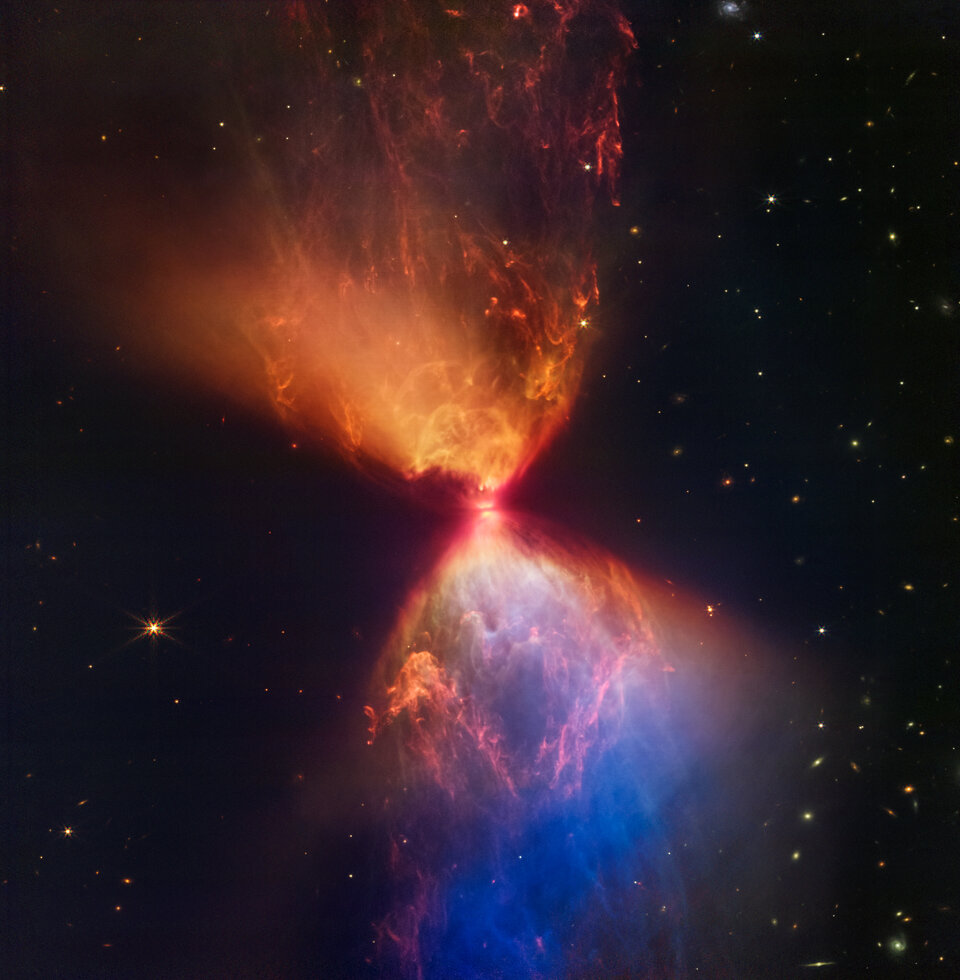
In a new study, a team of researchers at RIKEN used data from the Atacama Large Millimetre/sub-millimetre Array (ALMA) and the Jansky Very Large Array (JVLA) to probe the obscuring disk. The formation of planets is one of the foundational aspects of astronomy and has long been hidden from view and only theorized about. Scientists at RIKEN are bringing some of the processes into view.
The disk around L1527 is 80 to 100 times wider than the distance between Earth and the Sun, called an astronomical unit (AU). For comparison, Neptune is 30 AU from the Sun. (The inner main region of our Solar System’s Kuiper Belt ends at about 50 AU, and a second region extends as far as 1,000 AU.)
The disk is unstable, and a part of it appears to be collapsing. The collapsing region is about 20 AU from the protostar, and previous observations showed several clumps, which astronomers interpret as forming planets. This new study contains further observations of the disk and its clumps, including temperatures, and is titled “Formation of Dust Clumps with Sub-Jupiter Mass and Cold Shadowed Region in Gravitationally Unstable Disk around Class 0/I Protostar in L1527 IRS.” It’s published in The Astrophysical Journal, and the lead author is Satoshi Ohashi, a researcher at RIKEN.
“These clumps may be the precursors of gas giant planets since they are massive and dense,” Ohashi said in a press release. Since the protostar is only 100,000 years old, the observations suggest that planetary formation can begin very early in a circumstellar disk.
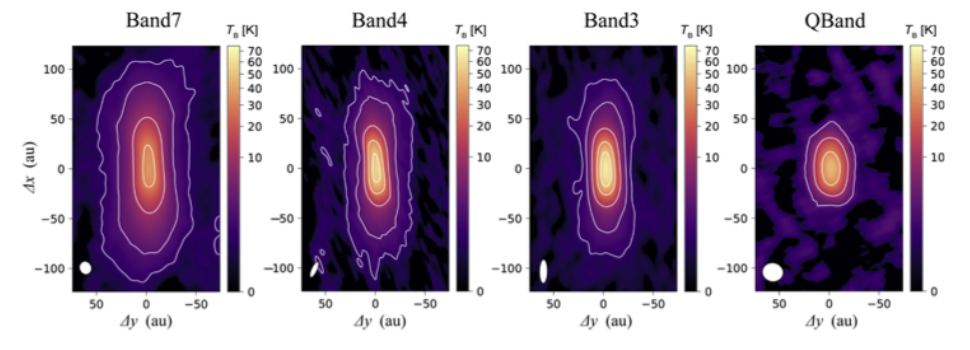
The team also measured the temperature in the disk, which is lower further from the young star. That’s to be expected. But the surprising result is what happens in the shadows of the baby gas giants.
In the inner region of the young solar system, close to the star, the temperature is ~193 degrees Celsius, which is warm in astronomical terms. When the team measured the temperature further out, on the far side of the clumps, the temperature was significantly lower at about –263 degrees Celsius. That’s very cold, only 10 degrees above absolute zero.
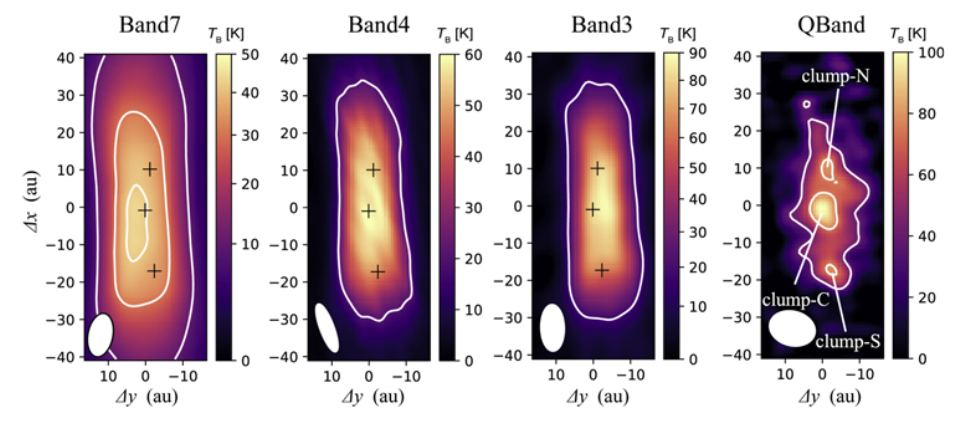
That’s a sharp drop and can’t be explained by distance alone, according to the researchers. It implies that the clumps are shading the regions beyond them and affecting what types of objects can form out there. Lead author Ohashi says the temperature drop can affect the composition of objects that form in the outer disk beyond the nascent gas giants.
Dust and gas temperatures are critical aspects of planetary formation. It’s strongly related to a solar system’s frost line, a demarcation between the inner system where terrestrial planets form and the outer system where volatiles like methane, ammonia, and carbon dioxide turn to solids. A solar system’s frost line changes over time. It moves outward as the star becomes more energetic and as the gas and dust clear away, so the formation frost line and the current frost line can be different. In our Solar System, the line has migrated outward since its formation, but in a young system like L1527, the frost line won’t have shifted much.
If the baby gas giants are casting a shadow on regions beyond them, then it’s reasonable to think that different volatiles will condense there compared to unshadowed regions, just as they do beyond the frost line. As a result, planetary atmospheres could be different in shadowed regions, just as if they were on different sides of the frost line.
The observed clumps and the drop in temperatures aren’t the only indications that planets are forming. A 2019 study found different orbital planes between the inner and outer parts of the disk. The outer parts are misaligned with the central star’s equatorial plane. What causes the misalignment?
Previous research showed that gas giants could be causing it via gravitational scattering, or companion stars or even stellar fly-bys could be causing it. But those conclusions came from research into young disks in general, not specifically L1527. This new study refutes those causes and strongly suggests nascent gas planets are the culprit while still acknowledging the ongoing debate.
The researchers concluded that gravitational stability is creating the clumps. The gravitational instability could be caused by spiral arms or by fragmentation of the disk. Other studies have shown that spiral arms can cause instability that leads to clumps. “Spiral arms are commonly observed in gravitationally unstable disks,” the authors write.”We investigated whether spiral arms can be observed as clumps in an edge-on disk, similar to the VLA clumps in the L1527 disk.”
They produced a model of spiral arms that could create the clumps and an edge-on simulated view of the same.
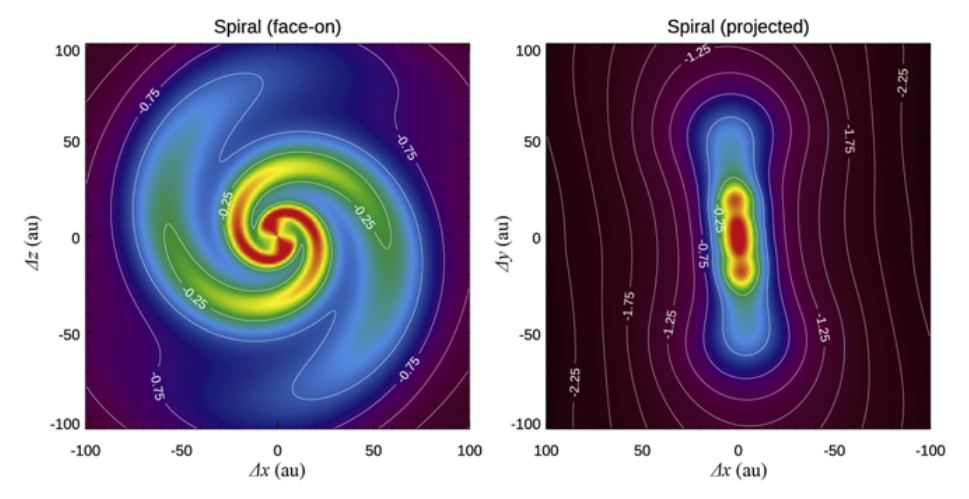
Other researchers have investigated the disks around young protostars with ALMA, and this isn’t the first time researchers have found cooler, shadowed regions in their disks. “These results suggest that the shadowing effect may be a common possible structure in the disks as well as the envelopes,” the authors write in their paper.
There’s another possible future where these clumps never become planets. Instead, they could be drawn to the star and accreted, never to become planets at all. “Rather than planet formation, it may also be possible for the VLA clumps to accrete to the central star and cause an accretion burst, such as in the case of FU Orionis,” they write.
FU Orionis is a young stellar object that undergoes accretion outbursts at a rate that increases over a period from several decades to 100 years. The authors found that the clumps around L1527 are sufficiently massive to cause similar outbursts. “The masses of the VLA clumps are sufficient to increase the accretion rate, should these clumps accrete to the central star via migration,” they write. “Thus, the VLA clumps might be the origin of future accretion bursts.”
The authors lean towards the clumps being young gas giants, though they do have one reservation. At the end of their paper, they clearly state a caveat for their conclusions. It’s based on different models for dust surface density and dust opacity, which is an important building block of their conclusions. Studies like these rely on models developed by other researchers, and over time these models become better and better and constrain results more accurately. There are models on top of models.
They acknowledge that the dust model they used isn’t the only model. “If we apply these opacity models, it is only possible for the disk to be gravitationally stable with Q > 2.0 when the dust grains are larger,” they explain. “Although we have suggested that gravitational instability is the likely origin of the substructure <the clumps>, other mechanisms may have created the shadowing effect at r ~ 20 au.”
(Q is short for the Toomre Q parameter – Index. It’s a value that reveals the stability of differentially rotating disks and takes into account thermal pressure, radial velocity, and other factors. It’s constructed so that Q < 1 implies instability.)
The only way to determine the nature of the clumps more accurately is to obtain higher-resolution observations. “Further observations at higher spatial resolution and greater sensitivity are needed to confirm the origin of the substructures,” the authors explain.
In general, the study shows that protostars this young have disks massive enough to generate the gravitational instabilities that lead to planetary formation. “Thus, we suggest that Class 0/I disks can be sufficiently massive to be gravitationally unstable, which might be the origin of gas giant planets in a 20 au radius.”
What effect will these young gas giants have on future planet formation inside their shadows? Can they lower the temperature enough to determine the types of planets that form beyond them?
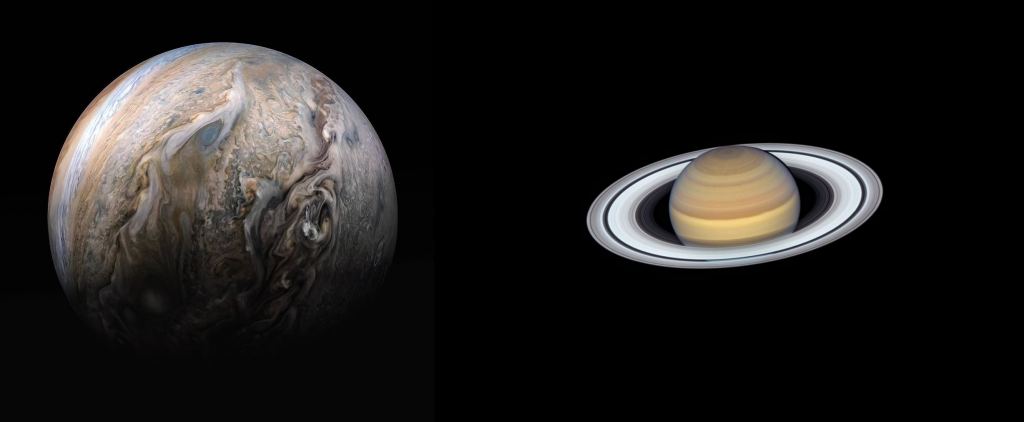
This study is like looking back in time to when our own Solar System formed. Jupiter and Saturn are both gas giants, while the two planets beyond them are not; they’re ice giants. Could young Jupiter and young Saturn have formed first, casting cool shadows that influenced the formation of the icy giants Uranus and Neptune?
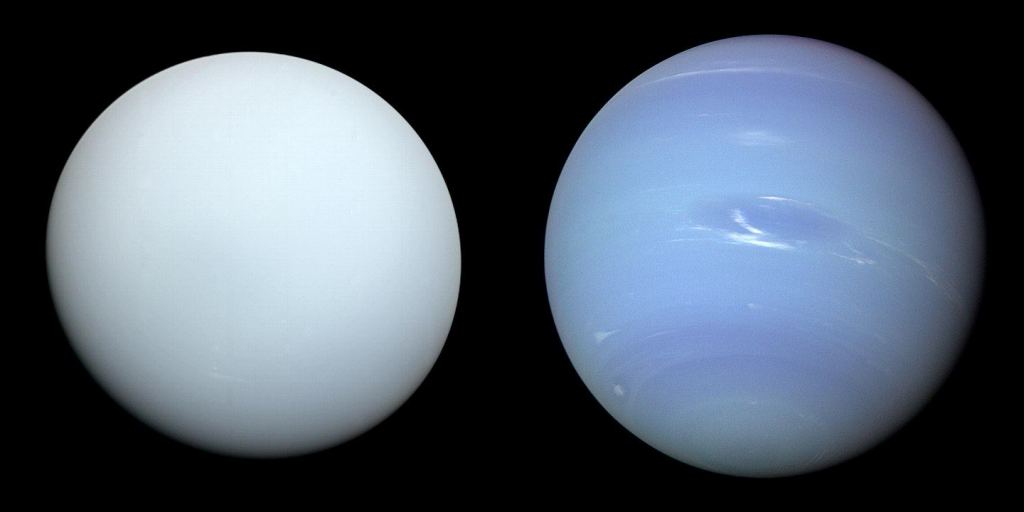
“Our Solar System is also suggested to have formed a shadowed region in the past,” says Ohashi.
It’s possible.
More:
- Press Release: Nascent gas giant planets may be lurking in dusty disk
- Published Research: Formation of Dust Clumps with Sub-Jupiter Mass and Cold Shadowed Region in Gravitationally Unstable Disk around Class 0/I Protostar in L1527 IRS
- Universe Today: We’ve Now Seen Planet-Forming Disks Around Hundreds of Young Stars. What Do They Tell Us?
The post Baby Gas Giants Cast Shadows on Their Siblings appeared first on Universe Today.
No comments:
Post a Comment